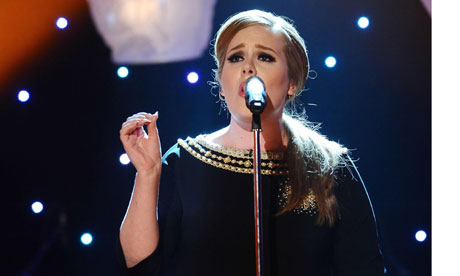
Shop dummies are getting bigger. Which is good. If only the world had left it there. If only there wasn't this rush to the phones, this scramble to hang the news on a human peg. Mannequins in size 12 and above (which have seen a 16% increase in sales to the UK's clothing chains) are being reported as "Adele-sized".
Some background: there's a singer called Adele, who everyone says they love because, as well as having a nice voice, she's a size 16. She's a "plus-sized", "shapely", "real woman" who, by "embracing her curves", is responsible for a "return to the fuller figure". All phrases painted sloppily in shades of tact, like badly Ronsealed fences. All phrases that underline the reality that Adele looks different from the celebrities usually thrust our way. Phrases that attempt to deal with our shock that, despite the fact she can't get her hands around her waist, she seems… happy.
There are rules to these conversations, rules that become clear only when they're broken. There was uproar when Karl Lagerfeld said Adele was "a little too fat". Uproar that ignored the fact the comment came from a man who (while a fabulous performance artist, with his 70 iPods and love of escorts) long ago proved he was a far from sane voice in fashion. A man who lost 6½st in a year and today says he only eats chocolate "with my nose". So yes, a man whose opinion on weight we should perhaps just nod along to kindly.
But while commentary on her "fat" is offensive, the discussion of Adele's body with words like "curvy" (there's a whole language in which women's magazines talk about size 16s) is seen as "liberating", "positive", a concept to be returned to again and again like a hand to a Pringles tube. The thing is, it's the same conversation. Whether it's Karl spitting expensively about fatness, or a well-meaning editor hooraying Adele's "womanliness", it's a conversation that uses one young woman's body to teach us how to change our own. It's the same journey, but in different vehicles. Whether you call her "fat" or "shapely" you end up in the same place, equally exhausted. At times it feels like these discussions are simply women making sense of the fact that, despite everything we've been taught (about fat representing laziness, poverty, stupidity), we think Adele is wonderful. We stand, baffled, blinking into the sun, stuttering: "But… but…"
And inevitably, as is the way when a "larger lady" does well, her weight gets fashionised. Mannequin manufacturer Jim Moody tells us: "Curves are back and set to stay this spring-summer." Thanks for the heads-up, Jim! I'll just dust off my spare tits! Grazia recently told us the same thing (referring to Cheryl Cole's imperceptible weight gain) and the Sun offered Christina Hendricks's bosom as proof again that "curves are back", noting that standing next to her, Sarah Jessica Parker looked "somewhat… masculine". Is this how we've learned to justify the success of people who aren't thin? By treating their weight as an accessory? As if Adele's body is a Prada dress she's slipped into for awards season, rather than "her". The place she lives.
What makes me particularly angry about the appropriation of Adele by fashion magazines and mannequin makers is that (aside from the fact that few retailers are actually making plus-sized clothes, or even the simple oversight that the shop dummies aren't actually "Adele-sized", whoops) these potentially positive observations about body image and celebrity are simplified to the point where they become muddy and damaging.
Whether the trend is thinness or fatness, we should not be encouraging each other to change our body shapes for fashion. For one thing, it's impossible. However many pounds we lose or put on, these are our bodies, our bones – we know that we'll usually end up exactly where we began. Mannequins can change, but our bodies really can't.

